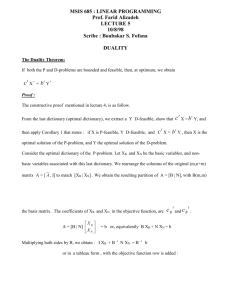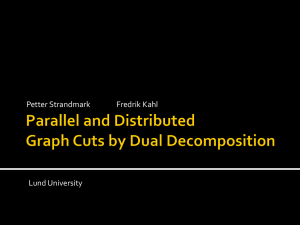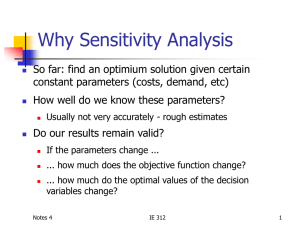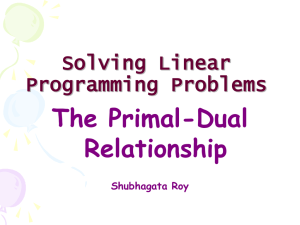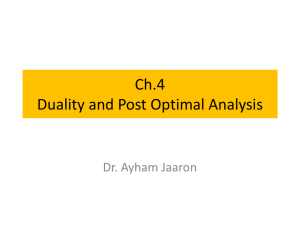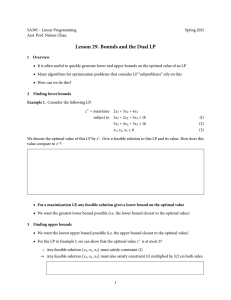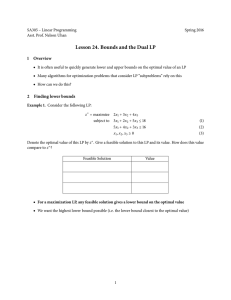PowerPoint Slides
advertisement
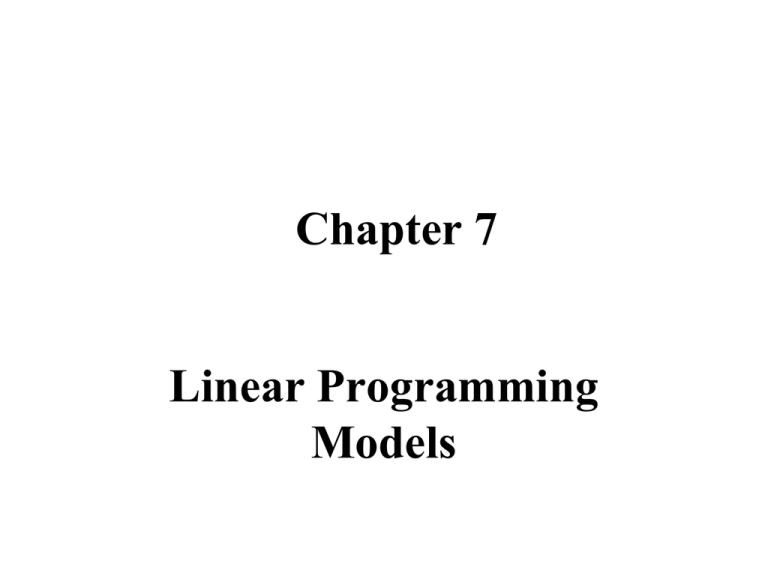
Chapter 7 Linear Programming Models Part One Basis of Linear Programming Linear Program formulation Linear Programming (LP) Linear programming is a optimization model with an objective (in a linear function) and a set of limitations (in linear constraints). A Linear Program Max S.T. X1 + 2X2 3X1 + X2 <= 200 X2 <= 100 X1, X2 >= 0 LP Components Decision variables - their values are to be found in the solution. One objective function – tells our goal. Constraints - reflect limitations. Only linear terms are allowed. Linear Terms A term is linear if it contains one variable with exponent one, or if it is a constant. Examples of linear terms: – 3.5X 2X 4 68.83 (3.78)6X1 7 X1 22 Examples of non-linear terms: – – 5X2 X2.5 X1X2 Log X sin X X3 5 8X X Format of a Linear Program Align columns of inequality signs, variable terms, and constants. Variable terms are at left, constant terms are at right (called right-handside, RHS). Non-negative constraints must be there. LP Solution A solution is a set of values each for a variable. A feasible solution satisfies all constraints. An infeasible solution violates at least one constraint. The optimal solution is a feasible solution that makes the objective function value maximized (or minimized). LP Solution Methods Trial-and-Error (brute force) Graphic Method (Won’t work if more than 2 variables) Simplex Method (by George Dentzig) (Elegant, but time-taking if by hand) Computerized simplex method (We’ll use it!) George Dantzig 1914-2005 Inventor of Simplex Method. Professor of Operations Research and Computer Science at Stanford University. To Solve a Problem by Linear Programming Formulate the problem into a linear program (LP). Enter the LP into QM. QM solves LP and provide the optimal solution. Formulate a Problem into LP To formulate a decision making problem into a linear program: – – – Understand the problem thoroughly; Define decision variables in unambiguous terms; Describe the problem with one objective function and a few constraints, in terms of the variables. Flair Furniture, Example, p.252 Products Resources Tables Chairs Carpentry Painting Profit per unit 4 hrs/unit 2 hrs/unit 3 hrs/unit 1hr/unit $70 $50 Resource available 240 hrs 100 hrs Find how many tables and chairs should be produced to maximize the total profit. Flair Furniture, Example, p.252 Definitions of variables: LP formulation: Solution from QM Tips of Formulating LP What – Those amounts you want to decide. What – is the ‘objective’? Profit (or cost) you do not know but you want to maximize (or minimize). What – are variables? are ‘constraints’? Restrictions of reaching your ‘objective’. Holiday Meal Turkey Ranch, p.270 Composition (oz/pound) Brand 1 Brand 2 Min. req. Ingredient feed feed per turkey A 5 10 90 oz B 4 3 48 oz C 0.5 0 1.5 oz Cost per 2 cents 3 cents pound Find how many pounds of brand 1feed and brand 2 feed should be purchased with lowest cost, which meet the minimum requirements of a turkey for each ingredient. Holiday Meal Turkey Ranch, p.270 Definitions of variables: LP formulation: Solution from QM: Formulating To formulate a business problem into a linear program is to re-describe the problem with a ‘language’ that a computer understands. The key concern of formulation is: – whether the LP tells the story exactly the same as the original one. Formulating is synonymous with ‘describing’ and ‘translating’. It is NOT ‘solving’. “Team Work” The process of solving a business problem by using linear programming is a team work between us and computers: – – We formulate the problem in LP so that computers can understand; Computers solve the LP, providing us with the solution to the problem. Irregular LP Problems A regular LP has one optimal solution. An irregular LP has no or many optimal solutions: – – – Infeasible problem Unbounded problem Multiple optimal solutions Redundancy refers to having extra and un-useful constraints. Part Two Shadow Price (Dual Value) Sensitivity Analysis Dual Price Each dual price is associated with a constraint. It is the amount of improvement in the objective function value that is caused by a one-unit increase in the RHS of the constraint. It is also called Shadow Price. In a product-mix problem As in the Flair Furniture example, a dual price is: – – – the contribution of an additional unit of a resource to the objective function value (total profit), i.e., the marginal value of a resource, i.e., The highest “price” the company would be willing to pay for one additional unit of a resource. Primal and Dual in LP Each linear program has another associated with it. They are called a pair of primal and dual. The dual LP is the “transposition” of the primal LP. Primal and dual have equal optimal objective function values. The solution of the dual is the dual prices of the primal, and vice versa. More on Dual Price: A dual price can be negative, which shows a negative ( or worse off) contribution to the objective function value by an additional unit of RHS increase of the constraint. Sensitivity Analysis (S.A.) S.A. is the analysis of the effect of parameter changes on the optimal solution. S. A. is conducted after the optimal solution is obtained. S.A. on Objective Coefficients Sensitivity range for an objective coefficient is the range of values over which the coefficient can change without changing the current optimal solution. S.A. on RHS Sensitivity range for a RHS value is the range of values over which the RHS value can change without changing the dual prices. S.A. on other changes To see sensitivities on following changes, one must solve the changed LP again: – – – Changing technological (constraint) coefficients Adding a new constraint Adding a new variable Why doing S.A.? LP is used for decision making on something in the future. Rarely does a manager know all of the parameters exactly. Many parameters are inaccurate “estimates” when a model is formed and solved. We want to see to what extent the optimal solution is stable to the inaccurate parameters. Sensitive or In-sensitive? Do we want a model more sensitive or less sensitive to the inaccuracies (changes) of parameters in it ? Answer: Less sensitive. Why? – An optimal solution that is insensitive to inaccuracies of parameters is more likely valid in the real world situation.

